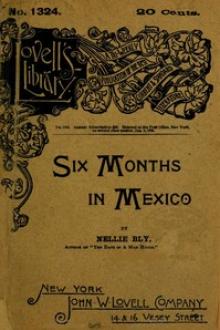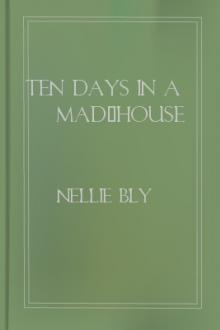Six Months in Mexico by Nellie Bly (best classic literature TXT) 📕

- Author: Nellie Bly
- Performer: -
Book online «Six Months in Mexico by Nellie Bly (best classic literature TXT) 📕». Author Nellie Bly
There are potteries located here where the Indians make all sorts of queer little things, which have some claim to beauty, and are bought by the natives as well as foreigners. There is some talk of making a pleasure resort at the village of Papotla, the historic Noche Triste, where Cortes, when flying from the furious Aztecs, ordered a short halt, and, sitting down under an old knotted and gnarled cypress tree, wept at his failure. The tree is not a thing of beauty and has very little life remaining in it now; the top has been removed, and it has been badly burned on the inside by some one who had no love for the memory of Cortes. A large iron fence now surrounds it, and effectually blocks the destroyers or trophy gatherer’s hand from further vandalism. A pleasure resort might do well here, as the surrounding country is beautiful. Between here and the city is the canal over which the Spanish commander, Alvarado, made his famous leap, thereby saving his life. Stories of it differ.
One says that a wet, mossy log crossed the canal, and the Spanish, seeing this their only means of escape, tried to cross. The condition of the log caused them to slip, and they were drowned in the depths below. When Alvarado came to it and saw the fate of the others, he stuck his spear, or halberd, into the center and safely sprung over. Still others claim he made the leap without the aid of an intervening log.
Another pretty story has been exploded. In the botanical garden at the palace they have the celebrated flower Tzapalilqui-Xochitl, of the Aztecs. The story runs that there are only three of the kind in the world - one at the palace, another at a different point in Mexico, and the mother plant on the mountain. At one time two tribes had a long and bloody war for the possession of it, so the story goes, but with a great deal more exaggeration. The plant is commonly called the “flower-hand,” as they claim that inside is a perfect baby hand. I went to see it, and was much disappointed. The tree grows to a good height. The leaves, heart-shape, are thick and about the color of the under part of a silver-maple leaf, except that they are very rough, which prevents them from glistening like the maple. The thick, waxlike, bell-shaped red blossom grows mouth upward, and inside is the so-called hand. It has five fingers and one thumb, but looks exactly like a bird’s claw, and not like a hand. The story ran that there are but three in existence. Without doubt the plant is rare and there may be no more than a dozen, if that many, in the world; but I have seen in the gardens of two different gentlemen the very same tree. One of these gentlemen is in Europe, and the other bought his plant from him, so there was no way of learning where the tree came from.
Mexican houses are built to last centuries. It is a common thing to see houses two hundred years old, and they are better than many they are putting up to-day, for they are adopting the American style of building in as small a space as possible, the structures to stand for a few years. The house where Humboldt lived is near the center of the city. It is not kept as a monument to his memory, as one would suppose when they think of the professed love of Mexico for him, but is occupied by a private family. The only thing that marks the house from those surrounding it is a small plate above the door, on which is inscribed: “To the memory of Alexander Humboldt, who lived in this house in the year 1808. In the centennial anniversary of his birth. The German residenters. September 14, 1869.”
At Tacubaya, two miles from the city, there is a large tree, about one hundred and seventy feet in height. It is green, winter and summer, and was never known to shed its leaves, which are of a peculiar oblong shape and a beautiful livid green. For the reason that it never sheds its leaves it derived the name of “the blessed tree;” the large fountain at the foot, which furnishes the water for the poor of the village, is called “the fountain of the blessed tree,” and the pulque shop and grocery store opposite are named “the pulque shop and the beautiful store of the blessed tree.”
Mexico is the hotbed of children; the land is flooded with them, and a small family is a thing unknown; they greet you at every window, at every corner, on every woman’s back; they fill the carriages and the plaza: they are like a swarm of bees around a honeysuckle - one on every tiny flower and hundreds waiting for their chance. A man died the other day who was followed to the grave by eighty-seven sons and daughters, and had buried thirteen, more than you can count in three generations in the States, so he was a father to the grand total of one hundred children. There is another man living in Mexico who has had two wives, and who has living forty-five children. Down in a small village, out from Vera Cruz, is a father with sixty-eight children. Allowing the small average of five to a family, one can see how numerous the grandchildren would be. I am acquainted with a gentleman whose mother is but thirteen-and-a half years older than he, and she has eighteen more of a family. It is a blessed thing that the natives are able to live in a cane hut and exist on beans and rice, else the lists of deaths by starvation would be something dreadfuL
CHAPTER XIX.
A DAY’S TRIP ON A STREET CAR.
AFTER being annoyed by the porter for two hours, who feared we would miss the train, our party of two at four o’clock in the morning started for Jalapa. Even at this unholy hour a large crowd had gathered at the station, where they busied themselves packing their luggage aboard. Every woman had one male escort, some several. The Mexicans surveyed myself and my chaperone in amazement, but I defied their gaze and showed them that a free American girl can accommodate herself to circumstances without the aid of a man. The mozo who had carried the bothersome sachel demanded “un peso” (one dollar), which I very promptly refused, and gave him the smallest change from my purse - twenty-five cents. The seats run lengthwise, like in an ordinary street car, and a Frenchman sitting opposite, who witnessed our little transaction and my very limited knowledge of Spanish, remarked: “Well, mademoiselle, you are smarter than I. A man charged me one dollar and a half just for the same service that one rendered you, and, although I speak Spanish, I had to pay it.”
The occupants of the car were the Frenchman and his wife, a musician, wife and sister-in-law, a Mexican and Frenchman solitaire, as they say here, and ourselves. It was far from daylight, so, making themselves as comfortable as possible, they all went to sleep. The Mexican women were dressed in plain black, with black veils and very high hats; they carried little black hand sachels, wore no gloves, and their fingernails, easily a half-inch longer than the finger, were cut in the bird-claw shape then so fashionable. The Frenchwoman did not look very pretty, as she slept with her mouth open. She was dressed in red silk, with red hat and veil, yellow gloves and linen duster. She was very fleshy, and had, besides a hand sachel, a cage in which were two brown birds dotted with red, which they informed us later were French canaries. Her husband was about six feet three inches, and weighed undoubtedly three hundred pounds. The solitaire Frenchman was bald-headed, and had white side-whiskers, which stood out at right angles to the length of one foot; his whiskers were the largest part of him. The Mexican had a very red nose, extremely thick lips, and was rather effeminate-looking. The married Mexican looked exactly like a jolly Irishman - something very extraordinary. After I had finished this inspection by the dim light of a lamp which hung in the center of the car, I too went to sleep, and knew no more till the train stopped at the journey’s end, a few miles out from Vera Cruz.
It ended the train’s journey, but not ours, for the rest of the trip is made by tramway. The cars are very high, have four seats, and the rays of the sun are excluded by a tin roof and canvas sides. Six mules do the hauling, and two cars - first and second-class - are run each way daily. They run on a regular iron track, as it was once the intention to run steam cars here. A great deal of freight is hauled in this manner. The village surrounding this station is entirely composed of straw huts. We were soon seated in the tram car, our number increased by the guardsmen, who, as the old saying goes, were armed to the teeth. A bell rang, and off we started with a rush, the second-class car keeping close to us. Our happiness would have been supreme had not the driver lashed his mules continually. The scenery was fine. The tall, graceful palms, the cocoa trees, the thousands upon thousands of beautiful orchids and wild flowers, the many-colored birds, some piping heavenly strains, others taking their morning bath in the running stream which crept along the wayside with a dreamy murmur; the delightfully fragrant, balmy air, everything seemed to lend its aid to make the scene one of indescribable loveliness. It was interesting to note the homes and home life of the natives in this rural spot; their straw houses are built simply by setting trees for corner posts and sticking the cane into the ground around them. The roof, of cane, grass, or palm leaves, always runs up to a high peak. Generally every house has a porch and more rooms than one, but never any other floor than the ground. Sometimes they exhibit good taste in building and one house will have several rooms, two or more porches and pretty peaks and curves which one would think impossible to make of cane; the furniture does not cost much, it consists entirely of petates; they furnish the tables, the beds, the chairs, and, suspended by a rope, make a comfortable swinging cradle for the babies. This useful piece of furniture is nothing more or less than a mat, woven by themselves in plain or colored straw; these people, no difference how poor, own burros, dogs, chickens, pigs, and other domestic animals, which do not occupy outside or separate houses, but live, sleep, and eat right in among them. A pig is as much at home in the kitchen or parlor as in a mud puddle. It is no uncommon sight to see sleeping children





Comments (0)